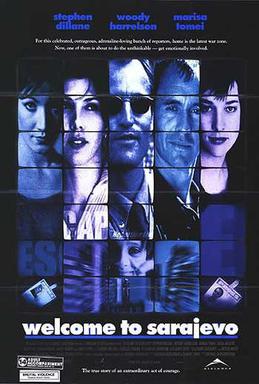
The siege of Sarajevo was a prolonged blockade of Sarajevo, the capital of Bosnia and Herzegovina, during the Bosnian War. After it was initially besieged by the forces of the Yugoslav People's Army, the city was then besieged by the Army of Republika Srpska. Lasting from 5 April 1992 to 29 February 1996, it was three times longer than the Battle of Stalingrad, more than a year longer than the siege of Leningrad, and was the longest siege of a capital city in the history of modern warfare.
As a historic city, Sarajevo has numerous myths and folklore. The character Nasrudin Hodža is popular throughout the former lands of the Ottoman Empire, and Sarajevo is no exception. Numerous stories about him dealing with the city have been written over the years. A famous piece of Sarajevo folklore is the story of the Eastern Orthodox Church. It was said that when a request came to build it, authorities required that it be no higher than the tallest minaret in Sarajevo. A wise old man was then said to have advised that the church be built into the ground. Thus the building reached a proper height but met the restrictions.

Romeo and Juliet in Sarajevo was an international documentary about the deaths of Admira Ismić and Boško Brkić. The couple were natives of Bosnia and Herzegovina living in the city of Sarajevo. She was a Bosniak, and he a Bosnian Serb. They were killed by sniper fire on 19 May 1993, while trying to cross the Vrbanja bridge to the Serb-controlled territory of Grbavica. Mark H. Milstein's photograph of their dead bodies were used by numerous media outlets, and a Reuters dispatch about them was filed by Kurt Schork. The documentary was co-produced by PBS's Frontline, the Canadian Broadcasting Corporation, the National Film Board of Canada and WDR Germany. It was directed by John Zaritsky.

Welcome to Sarajevo is a 1997 war drama film directed by Michael Winterbottom, written by Frank Cottrell Boyce and is based on the book Natasha's Story by Michael Nicholson. The film stars Stephen Dillane, Woody Harrelson, Marisa Tomei, Emira Nušević, Kerry Fox, Goran Višnjić, James Nesbitt, and Emily Lloyd.
Miguel Gil Moreno de Mora was a Spanish cameraman and war correspondent, working for Associated Press.
Martin John Lars Adler was a Swedish cameraman and journalist for Aftonbladet. He was a veteran, award-winning reporter known for his war reports and foreign coverage.

Suada and Olga Bridge, also known by its old name Vrbanja Bridge is a bridge across the Miljacka river in Sarajevo.

Haris Pašović is a Bosnian theatre director. Over the course of his career, he has also worked as a playwright, producer, choreographer, performer, and designer. He is best known for his productions of Wedekind's “Spring Awakening”. He is the artistic leader of the East West Theatre Company in Sarajevo and tenured Professor of Directing at the Academy of Performing Arts in Sarajevo.

Harry Burton was an Australian journalist and cameraman who was kidnapped by the Taliban on the highway to Kabul, Afghanistan and then murdered. Three other journalists suffered the same fate.

Reuters is a news agency owned by Thomson Reuters Corporation. It employs around 2,500 journalists and 600 photojournalists in about 200 locations worldwide. Reuters is one of the largest news agencies in the world.
Ismet "Ćelo" Bajramović was a Bosnian soldier and reputed organized crime figure from Sarajevo.

Yannis Behrakis was a Greek photojournalist and a Senior editor with Reuters.
Hiro Muramoto was a Japanese TV cameraman and journalist, who worked for the Australian Broadcasting Corporation in Tokyo in the 1990s, and who reported for Reuters television for more than 15 years. Muramoto was based in Reuters' Tokyo bureau.
Brkić is a surname borne by Bosniaks, Croats and Serbs. Notable people with the surname include:
Rémy Ourdan is a French journalist, war correspondent for the newspaper Le Monde, and documentary filmmaker.
Boško is a Slavic male given name. It may refer to:
Iona Craig is a British-Irish freelance journalist. Since 2010 her reporting has focused on Yemen and the Arabian Peninsula.
In the 1994 roadside attack on Spin magazine journalists on May Day during the Bosnian War, two journalists, Bryan Brinton and Francis William Tomasic, were killed by a landmine, and journalist and novelist William T. Vollmann was injured near Mostar in Bosnia and Herzegovina.








